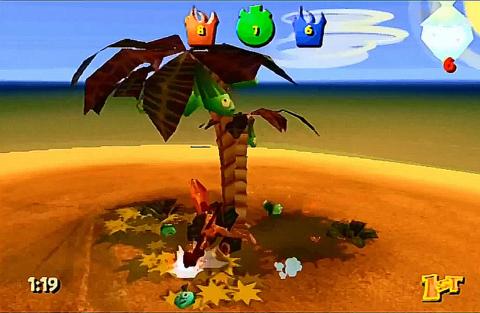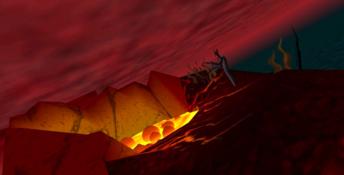Ooga Booga

| a game by | Visual Concepts |
| Platform: | Dreamcast |
| Editor Rating: | 9/10, based on 1 review |
| User Rating: | 10.0/10 - 2 votes |
| Rate this game: | |
| See also: | Download Fighting Games |
Overview
The volcano goddess Ooga Booga has created four different tribes to compete for her pleasure. Now it’s up to each of the four different tribes to become and stay the favorite of Ooga Booga by being the best in battle. Most fighting games don’t have much of a storyline -- this game is no different, although environment and characters are much more original than anything I’ve seen in a long time. Ooga Booga focuses mostly on multiplayer and online multiplayer competition. Think you have what it takes to appease her?
Gameplay, Controls, Interface
Ooga Booga is a simple fighting game that’s mainly designed to take advantage of multiplayer aspects. It’s divided up into three main modes -- Offline Skirmish, Online, and Tribal Trials. While you can go directly to an offline or online skirmish, it’s usually best to start with the Tribal Trials. The trials give you a much needed tutorial on how to play and these trials also allow you to unlock items and features of the game that otherwise wouldn’t be available (unless you use cheat codes, but you wouldn’t go and do that, now, would you?). The game will automatically save your progress after each trial. The trials themselves start off pretty easy and progress moderately in difficulty until you get to the 3-on-1 trials (that’s three computer opponents on a team versus you). I found these particular trials to be incredibly frustrating and difficult. I also had another friend who’s generally really good at these type of games try it and he agreed it was pretty outrageous. Unfortunately, you have to pass some of these to unlock further levels. The one thing I can say about this difficulty is that the computer AI is very good -- probably too good on those levels.
In addition to the 3-on-1 free-for-all (called "Smakahunas," also available in 2-on-2, 2-on-1-on-1 and everyone-for-themselves) there are two other types of games. One is called "Boar Polo," where you and a teammate compete to knock a rather large boulder through your opponent’s goal. The other is "Rodeo," which is like Smakahuna but you can only score by hitting people while riding a boar or knocking someone off a boar. Each game consists of rounds and within each round you have to score as many points as possible by smacking around your opponents in different ways. These consist of swatting, throwing shrunken heads, casting various spells such as lightning, fireballs, homing heads, tornadoes, mines, and several others. There are Tiki statues that you can take control of that then act similar to turrets. Boars and birds roam the islands and you can hop on and take a ride to get the upper hand, but be careful -- they’ll eventually dump you and may start attacking you. There are lots of hidden items and characters to unlock also. Each character has its own strengths and weaknesses. Although you can be smacked around in many different ways, you can never actually die. You don’t even have a life bar. If you go too far out to sea, a shark will come along and eat you, but you’ll just regenerate on the island so get back in there and fight!
Offline and online combat is more or less the same thing as far as how they play. When you create or join a skirmish, you’ll have all the items you’ve unlocked available to you. You can set up which island you’ll fight on, what spells and animals are available and whether or not you want human or computer opponents. I found the interface for setting this up to be slightly confusing at first but easy enough to take care of once you’re used to it. The online version requires an account with an ISP and if you’ve entered that with the Dreamcast Web Browser then it will use that same information (otherwise you can enter it within the game). Once connected to Sega’s network, you have to create an online name and password for yourself and then select a region and city to play in. Each region and city will list how many people are online at the current time. You can also chat with other players online, but it’s kind of rough and really slow unless you have a Dreamcast keyboard. The gameplay has a nice feel to it and makes good use of all of the buttons on the controller. The movement controls are responsive and easy to work with. The different attacks are all easy enough to execute, but some are more difficult to handle in the heat of a fast combat situation such as the homing heads since you have to aim them. There are also controls to handle the camera. The nice part is that you can set the camera to automatically stay behind you, set it to hold it’s position, re-center it behind you when it gets off track, or zoom in and out.
Multiplayer
The whole game is really designed around the multiplayer aspect. As long as you’re playing multiplayer on a single system the game plays great. Everything is smooth and you can move around as usual. It plays in a split screen but what can you do? After all, the best AI is a live person, right? Well, you could always play online -- sort of.
Unfortunately the online version of the multiplayer aspect failed miserably during my experiences with it. When you log on, you have the option of picking a region and then a city within that region. The closer the city, the less lag you should receive -- or so the manual claims anyway. I logged on several times over several different days and at different times. I was quite disappointed to see that there were never more than five people total online. Most of the time there was no one at all online in any city in any region. I was able to join about two or three games and the lag was absolutely horrendous -- even in my own city. In fact, in a four-player Smakahuna the lag was so bad the game was virtually unplayable. Even a two-player Rodeo on a small island with someone in my local city was choppy at best and frequently paused. I resorted to taking my Dreamcast to a friend’s house about 200 miles away to see if I could get better results and I wasn’t even able to connect to Sega’s network at all. (His regular computer connected to the net just fine with the same account on that same phone line.)
The online multiplayer aspect is especially a sore point with me since it is clearly one of the central selling points of the game and it’s mentioned in several places on the jewel case. And to top that, the press release states the president of the game’s development company said "…takes it to the next level with virtually lag-free play." I guess it’s possible that both phone lines in separate cities had problems or that Sega’s network was down or that no one felt like playing online at the times when I went on, but I’m generally that unlucky only in Vegas so I doubt it’s just coincidence.
Graphics
The graphics are very bright, colorful, and cartoony. The islands all have different types of terrain from sandy beaches with palm trees to grassy hills to volcanoes to stone altars. The backgrounds are pretty simple but then again, there isn’t much too see off a remote island but water and sky, right? The animation (except when playing online) is very smooth and fluid and the special effects are also nice to look at (but not get caught in because it usually means you just got hit).
Audio
The audio is wonderfully tropical. There are lots of stereotypical South Pacific sounds such as beating drums and tropical music going on in the background. The sound effects are great too but pretty standard quality for a Dreamcast game. The sound can be a very useful tool in that you can hear other things going on around you such as a tornado or a homing head and you may have a chance to get clear before it’s too late.
Documentation
You may want to take a quick look at the docs for the basic rundown or as a reference of what the different spells do or how many points you get for successfully using them. The manual also lists some useful info about each tribe that the game itself does not.
Originality / Cool Features
I found the theme of this game to be something very different from that in any game I’ve seen in quite a long time, which is refreshing. The usage of the online multiplayer is a great idea too assuming you can get it to work well.
Bottom Line
Ooga Booga has some great potential but considering how much focus is placed on the multiplayer aspect and considering all the problems with it online, I’d strongly suggest renting this game first if you’re planning on buying it to play online against other people. If, however, you’re gonna have a group of friends over and play some four-player local tournaments, you’re in for a really good time. I was originally planning on giving this game a score of around 90 due to its simplicity, great AI, and originality. Unfortunately the problems I ran into online (a major part of the game) as well as how incredibly difficult the game gets later in the Tribal Trials (which you need to pass in order to unlock items used in multiplayer) means I have to deduct some serious points, so I’m sorry to say I can only give this game a score of 75.
Download Ooga Booga

System requirements:
- PC compatible
- Operating systems: Windows 10/Windows 8/Windows 7/2000/Vista/WinXP


































 Pride FC: Fighting Championships
Pride FC: Fighting Championships
 NARUTO SHIPPUDEN: Ultimate Ninja Storm Trilogy
NARUTO SHIPPUDEN: Ultimate Ninja Storm Trilogy
 WWE Legends of WrestleMania
WWE Legends of WrestleMania
 Virtua Fighter 4
Virtua Fighter 4
 Tekken Advance
Tekken Advance
 Super Dragonball Z
Super Dragonball Z
 Street Fighter Alpha 2
Street Fighter Alpha 2
 Soul Edge
Soul Edge
 Soul Calibur V
Soul Calibur V
 Samurai Shodown 2
Samurai Shodown 2
 Rumble Roses
Rumble Roses
 Naruto Shippuden: Ultimate Ninja 5
Naruto Shippuden: Ultimate Ninja 5





